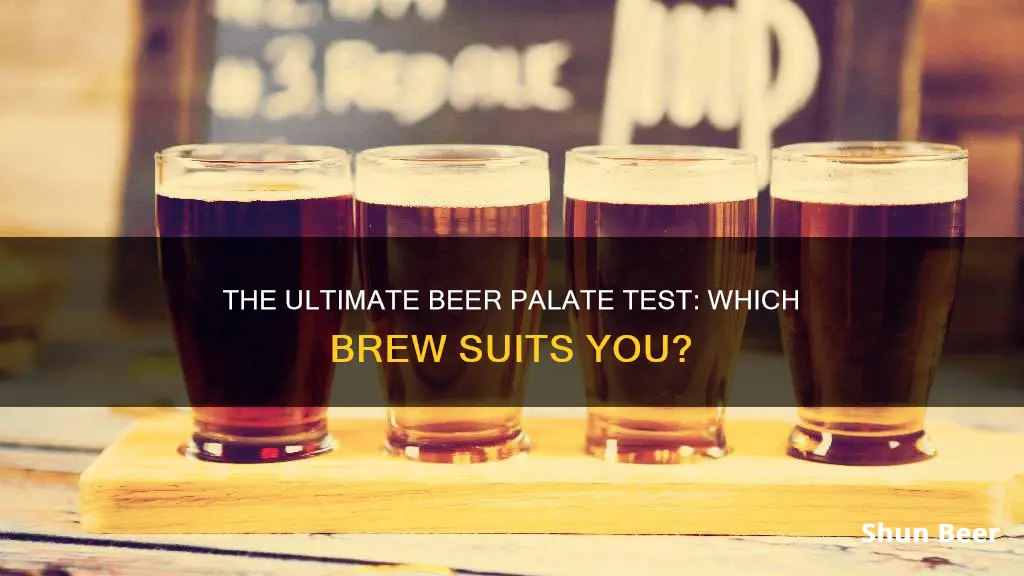
With the thousands of beers on the market, it can be challenging to choose the right brew to enjoy. Beers can be classified into two types: ales and lagers. Ales are created through top fermentation, and lagers are fermented with bottom-fermenting yeasts at cold temperatures for longer periods. Beer flavours can range from bitter to fruity to chocolatey, and the body can be light to full-bodied. To simplify the process of picking a beer, you can take a quiz that will give you a beer recommendation based on your flavour preferences and personality.
| Characteristics | Values |
|---|---|
| Number of Beers Available in the Market | Thousands |
| Beer Types | Lager, Ale, Belgians, Stouts, Bocks, Sours |
| Beer Flavor | Bitter, Fruity, Chocolate |
| Beer Body | Light, Heavy, Full-Bodied, Dark |
What You'll Learn

Ales vs lagers
All beer is either an ale or a lager, but the difference between the two is not as simple as colour, flavour, or alcohol strength. Instead, it is the fermentation technique and yeast used in brewing that separates the two.
Ales are fermented with top-fermenting yeast at warm temperatures (60˚–75˚F), and lagers are fermented with bottom-fermenting yeast at cold temperatures (35˚–55˚F). Ales can generally ferment and age in a relatively short period of time (3-5 weeks), whereas lagers take much longer (up to 6 to 8 weeks) because they are cold fermented. The warmer temperatures used for ales increase the rate of fermentation and the production of carbon dioxide, which is why the yeast rises to the top during fermentation. The colder temperatures used for lagers slow down the fermentation process and produce less foaming.
The two types of yeast used are almost always divided into two different species. The 'bottom-fermenting' yeasts are Saccharomyces pastorianus, commonly called lager yeast, and the 'top-fermenting' yeasts are Saccharomyces cerevisiae, commonly called ale yeast. However, there are some exceptions, or 'hybrids', where classic 'lager' yeasts are genetically 'ale' yeasts that have developed special adaptations, and vice versa.
The birth of the Pilsner style in the 1800s introduced much of the world to lagers, and since then, lager has become the most popular beer style in the U.S. However, the resurgence of ales in the past 40 years has expanded the palate of many beer drinkers and brought beauty and art back to brewing.
Drinking Beer in Rome: What You Need to Know
You may want to see also

Flavour preferences
When it comes to flavour preferences, there are a few things to consider when deciding which beer to drink. Firstly, do you prefer your beer to have a light, golden colour, or something darker, like amber, copper, or even black? Colour can often give an indication of flavour, with darker beers tending to have more robust flavours.
Secondly, do you like your beer to be cloudy or clear? A cloudy beer often indicates an unfiltered beer, which can have a more complex flavour profile due to the presence of yeast.
Thirdly, what type of undertones do you enjoy? Vanilla and nutty flavours can be found in some beers, as can chocolaty or coffee flavours. If you're not a fan of these, you might prefer a beer with fruity undertones, or even a specialty beer that is clearly fruity in taste.
Another important flavour consideration is the type of yeast and fermentation process used. Ales, for example, are brewed with top-fermenting yeast at warm temperatures, which gives them a sweet, full-bodied, and fruity taste. They often contain hops, which add bitterness and herbal, citrus, or floral notes. On the other hand, lagers are slow-fermented with bottom-fermenting yeast at cold temperatures, resulting in a milder flavour that can be light and refreshing.
Finally, think about the body of the beer, or how heavy or light it feels in the mouth. A full-bodied beer will have a stronger, more intense flavour, while a light-bodied beer will be more subtle and easy-drinking.
By considering these flavour preferences, you can narrow down the vast array of beers available and find the one that best suits your taste.
Drinking Beer in Ads: Is It Legal?
You may want to see also

Beer body
The body of a beer is a measure of its fullness of flavour and mouthfeel. It is determined by the levels of dextrins and medium-length proteins. A light beer is described as light-bodied, an India Pale Ale is considered medium-bodied, and a Doppelbock is full-bodied.
Body is technically separate from mouthfeel, which encompasses physical sensations such as astringency, alcoholic warmth, and carbonation. However, the combination of body and mouthfeel determines how the beer stimulates the palate.
The body of a beer can be rated on a scale from thin (light) to full (heavy), with descriptors such as sweet, neutral, dry, bland, vinous, firm, smooth, rough, and watery. The body of a beer can also be classified as proper or improper for the style of beer. For example, American lagers are classified as light-bodied, while bock beers and imperial stouts are considered full-bodied.
The body of a beer is influenced by various factors, including the type of malt, the amount of protein, the use of clarifying agents, and the filtration method. A good understanding of these techniques and processes can help brewers create a beer with the desired body and mouthfeel.
The Magic of Bottoms-Up Draft Beer: How Does It Work?
You may want to see also

Craft beers
Craft beer lovers are spoilt for choice, with a wide variety of flavours and styles available. Craft brewers are known for their creativity and often extreme flavours, such as double IPAs, beers with coconut, coffee, mango, or hot peppers, farmhouse ales with foraged ingredients, sour ales, and stouts aged in spirit barrels.
However, there is also a movement back towards classic lager styles, with a new wave of crushable lagers sweeping the craft beer world. These beers that taste like "beer" are often unfiltered and unpasteurised, with a cloudy appearance and a pillowy mouthfeel, accompanied by slightly rustic bready malt tones and a touch of hop bitterness.
- Zwickel by Urban Chestnut Brewing Co.: This unfiltered and unpasteurised lager has a naturally cloudy appearance and gorgeous, slightly rustic bready malt tones with a finishing kiss of German hop bitterness.
- Schell's Deer Brand by August Schell Brewing Co.: This is a pre-Prohibition lager made with 70% barley malt and 30% corn, yielding a light 4.8% ABV lager with a heritage dating back to the first evolution of American adjunct lagers in the 19th century.
- Trotwood Lager by Warped Wing Brewing Co.: This light, 4% ABV all-malt lager was originally brewed as a base for a radler, but became so popular that it was released on its own and quickly became the brewery's best-selling brand.
- Nite Lite by Night Shift Brewing: This simple, light lager is unfiltered and unpasteurised, with a corn base and a smooth, easy-drinking flavour.
- Slow Pour Pils by Bierstadt Lagerhaus: This pilsner is poured traditionally, taking about 4 minutes to build the head and soften the carbonation, resulting in a delicate flavour.
If you're looking for something a little stronger, here are some craft beer suggestions with higher ABVs:
- Jai Alai IPA by Cigar City Brewing: This India Pale Ale is one of the most popular versions of the style in the United States, known for its big, bold flavours.
- Victory Golden Monkey by Pennsylvania's Victory Brewing: This Belgian tripel packs notes of banana, clove, orange, and earthy hops, with a dry finish and an ABV of 7.5-9.5%.
- Bell's Two Hearted IPA: Hailing from Michigan, this award-winning IPA gets its name from the Two Hearted River and is dry-hopped with 100% Centennial hops, resulting in notes of grapefruit and pine.
- Chimay Grande Reserve: This Belgian Strong Ale boasts a bouquet of caramel, toast, plum, fig, raisin, pepper, and perfume notes with a boozy warmth.
For those who want to enjoy a craft beer without the alcohol, non-alcoholic options are also available, such as the Hellraiser dark amber from WellBeing Brewing Co., which looks and tastes like a craft ale but contains barely any alcohol.
Craft Beer Exploration in Palm Springs
You may want to see also

Food pairings
When it comes to food and beer pairings, there are a few key things to keep in mind. First, consider the weight and flavour intensity of the dish you're serving. Lighter beers tend to go well with lighter dishes, while fuller-bodied beers can stand up to richer, more robust flavours.
For example, a crisp and refreshing pilsner or wheat beer pairs beautifully with lighter fare such as salads, seafood, and chicken dishes. The bright, citrusy notes in these beers can accentuate similar flavours in the dish, creating a harmonious pairing. On the other hand, if you're serving a heartier meal, such as grilled meats or rich, creamy pasta, consider a bolder beer like an IPA or a stout. The strong flavours of these beers can hold their own against the dish, and the bitterness of an IPA can even help cut through the richness of the food.
Another important factor to consider is the presence of any dominant flavours or ingredients in your dish. For instance, if you're serving a dish with strong spicy notes, a beer with a subtle fruitiness, such as a hefeweizen or a Belgian ale, can help balance and cool the heat. Similarly, the sweetness of certain beers, such as a malt-forward amber ale or a bock, can be a great counterpoint to the savoury, umami flavours often found in dishes featuring soy sauce, mushrooms, or cured meats.
Don't be afraid to experiment and have fun with your pairings. Sometimes, unexpected combinations can yield delightful results. For instance, the bitterness of dark chocolate can be accentuated by the roasted notes in a stout, while the carbonation and crispness of a pilsner can cut through the richness of a creamy dessert such as cheesecake. Remember, the goal is to find a balance between the flavours in your food and beer, creating a symphony of tastes that enhances the overall dining experience.
Beer Options for Diabetics: What's Safe to Drink?
You may want to see also
Frequently asked questions
You should try an American lager with a light to medium body.
You should try a stout or a porter, which are known for their bold, rich flavours.
You might be a fan of India Pale Ale, or IPA, which is known for its bitterness.
You could try a lambic or a gose, which are known for their fruity notes.







